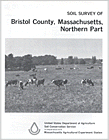Soil Survey of Bristol County, Massachusetts
NORTHERN PART

The following Map Unit Description is from the 1981 Soil Survey of Bristol County, NORTHERN Part. Please note: map unit symbols are DIFFERENT for Bristol North and Bristol South reports, do NOT use these descriptions for Bristol South.
Wa- Walpole fine sandy loam. This soil is deep, nearly level, and poorly drained. It is in low areas and depressions on glacial outwash plains. Slopes are smooth and nearly flat and are generally 100 to 600 feet long. The mapped areas are elongated or irregular in shape and are 5 to 60 acres in size.
Typically, the surface layer is very friable, very dark gray fine sandy loam about 3 inches thick. The sandy loam subsoil is 23 inches thick and is mottled. It is very friable and brown in the upper 17 inches and is friable and grayish brown in the lower 6 inches. The substratum to a depth of 60 inches is loose, pale olive gravelly loamy coarse sand that is mottled.
Included with this soil in mapping are areas of Wareham and Scarboro soils that are generally less than 4 acres in size. Also included are areas of gently sloping Walpole soil. The included soils make up 15 percent of the map unit.
Permeability is moderately rapid in the subsoil and rapid in the substratum. Available water capacity is moderate. Reaction ranges from very strongly acid to medium acid. The root zone extends into the substratum, but root growth is restricted by a seasonal high water table that is at or near the surface 7 to 9 months of the year.
This soil has fair potential for farming. The main farm use in undrained areas is unimproved pasture. The soil has poor potential for urban use and for sanitary waste disposal facilities. It has fair potential for trees. It has fair potential for openland and woodland wildlife habitat and good potential for wetland wildlife habitat. Most acreage is wooded. Some acreage has been drained and is used for farm crops.
The soil is not suited to cultivated crops, hay, and improved pasture unless it is artificially drained. The seasonal high water table restricts plant growth and limits use of machinery .If suitable outlets are available, the soil is generally easy to drain. Proper stocking rates, deferred grazing, and pasture rotation are management practices that help to maintain desirable pasture plants. Keeping livestock from pastureland when the soil is wet increases pasture and helps to prevent cutting the sod.
The soil is limited for trees. The high water table restricts growth, hinders stand reproduction, and limits use of machinery. Important tree species are eastern white pine and red maple.
The soil has limitations for urban use because of the seasonal high water table and high potential frost action. It has limitations for sanitary waste disposal facilities because of the high water table and rapid permeability in the substratum. Capability subclass IIIw.
Wb-Walpole Variant fine sandy loam. This soil is deep, nearly level, and poorly drained. It is on terraces. Slopes are smooth or very gently undulating and are 100 to 200 feet long. The mapped areas are elongated or irregular in shape and range from 5 to 40 acres in size.
Typically, the surface layer is very friable, black fine sandy loam about 3 inches thick. The subsoil is 25 inches thick. It is very friable, brown fine sandy loam in the upper 9 inches and is friable, light brownish gray fine sandy loam in the lower 16 inches. The subsoil has strong brown, yellowish brown, and light gray mottles. The substratum to a depth of 60 inches is firm, light olive gray loamy very fine sand that has strong brown and light gray mottles.
Included with this soil in mapping are areas of Amostown, Raynham and Birdsall soil that are generally less than 4 acres in size. Also included are areas of soils in which the surface layer and subsoil are loamy sand. The included soils make up about 20 percent of the map unit.
Permeability is moderately rapid in the subsoil and moderate to slow in the substratum. Available water capacity is moderate. Reaction ranges from very strongly acid to strongly acid. The root zone extends into the substratum, but root growth is restricted by a seasonal high water table that is near or at the surface 7 to 9 months of the year.
This soil has fair potential for farming. The main use in undrained areas is for unimproved pasture. The soil has poor potential for urban use and for sanitary waste disposal facilities. It has fair potential for trees. It has fair potential for openland and woodland wildlife habitat and good potential for wetland wildlife habitat. Much of the acreage is wooded, and some acreage is farmed.
The soil is not suited to cultivated crops, hay, and improved pasture unless it is artificially drained. The seasonal high water table restricts plant growth and limits use of machinery. Although suitable outlets are available in places, this soil is generally difficult to drain because of moderately slow permeability in the substratum. Proper stocking rates, deferred grazing, and pasture rotation are management practices that help to maintain desirable pasture plants. Keeping livestock from pastureland when the soil is wet increases pasture production and helps to prevent cutting the sod.
The soil is limited for trees. The seasonal high water table restricts growth, hinders stand reproduction and limits use of machinery. Important tree species are red maple and eastern white pine.
The soil has limitations for urban use because of the seasonal high water table and high potential frost action. It has limitations for sanitary waste disposal facilities because of the seasonal high water table and slow percolation in the substratum. Capability subclass IIIw.